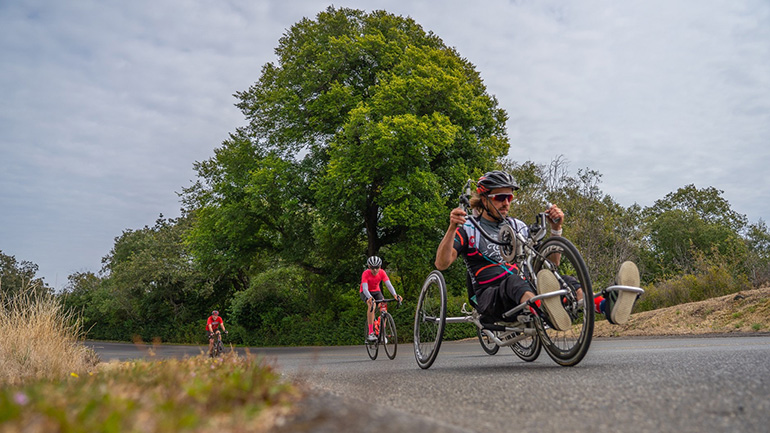
Vernon’s Josh Dueck is one of many people who have given the physical activity guidelines a test drive. Photo by: OI Canada
Researchers take the guesswork out of exercising effectively
A team of researchers has developed an online platform of tried and true resources to help people living with spinal cord injury (SCI) lead a more active life.
Professor Kathleen Martin Ginis is the director of the Centre for Chronic Disease Prevention and Management based at UBC Okanagan. She says a major barrier to physical activity for people with a spinal cord injury is a lack of knowledge or resources about the amount and type of activity needed to achieve health and fitness benefits.
“It’s really hard for people to be active, let alone people living with a spinal cord injury,” she says.
To complicate matters, an international consortium of experts created two international guidelines for people with SCI. One provides recommendations for using exercise to increase cardiorespiratory fitness and muscle strength while the other is a recommendation for using exercise to improve cardiometabolic health.
Both guidelines stipulate the minimum amount of aerobic exercise and strengthening exercises needed weekly.
“These are scientific guidelines, that are great for scientists,” says Martin Ginis, who led the international consortium of experts. “But for Canadians with an SCI, we didn’t provide a really clear path and clear information on how to implement those guidelines into a daily routine.”
Martin Ginis’s team, including staff from Spinal Cord Injury BC and researchers with the International Collaboration on Repair Discoveries, spent the past two years reviewing, analyzing and testing the guidelines. More than a hundred people from the SCI community provided feedback.
“We sat down with experts, scientists, clinicians, people living with spinal cord injury, and key organizations and asked how we can take this scientific information and put it into something that people with spinal cord injury can use,” she explains.
The end result is a concise combination of the two scientific exercise guidelines into one clear and understandable online physical activity guideline.
“After two years of research, we’ve provided an online tool that people with a spinal cord injury can use with confidence to become more physically active.”
Along with suggested amounts of cardio required each week, the research also provides strength training ideas and tips. Users will find links to community resources, suggestions on how to get started with a physical activity program and advice from people living with an SCI.
One such end-user is Vernon’s Josh Dueck, retired Paralympic athlete and current executive director for Freestyle BC. Injured in a skiing accident in 2004, Dueck has continued with an active lifestyle winning numerous accolades in the sport of para-alpine ski racing. He has worked with UBCO’s research team providing insight to the activity guidelines, which he says are easy to follow and should help promote an active lifestyle for the SCI community.
“There is a beauty in simplicity and the simple approach is often the most attainable,” Dueck adds. “The SCI physical activity guidelines take the mystery out of what is needed to keep your body and mind thriving. It brings great joy to know the base parameters to maintain a healthy life are accessible and achievable.”
Users will find beginner and advanced levels along with additional tips and suggestions to avoid chronic ailments like Type 2 diabetes and heart disease.
This research, partially funded by the Praxis Spinal Cord Institute and the Social Sciences and Humanities Research Council of Canada, is published in Nature’s Spinal Cord journal.